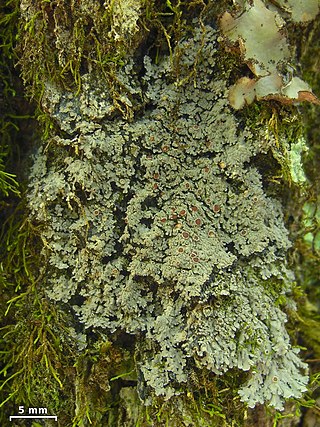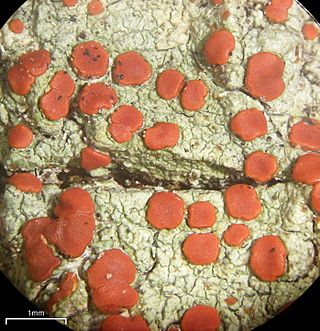
The Pannariaceae are a family of lichens in the order Peltigerales. Species from this family have a widespread distribution, but are especially prevalent in southern temperate regions.

Pannaria is a genus of lichen-forming fungi in the family Pannariaceae. The widespread genus contains an estimated 51 species, found primarily in tropical regions.

Fuscopannaria is a genus of lichen-forming fungi in the family Pannariaceae. It has 55 species.

Allocetraria is a genus of lichenized fungi in the family Parmeliaceae. It consists of 12 species, with a center of distribution in China.

Ramboldia is a genus of lichen-forming fungi in the family Ramboldiaceae. The genus was circumscribed in 1994 by Gintaras Kantvilas and John Alan Elix. It was emended in 2008 by the inclusion of Pyrrhospora species containing the anthraquinone russulone in their apothecia and having a prosoplectenchymatous exciple. The family Ramboldiaceae was circumscribed in 2014 to contain the genus.
Megalaria is a genus of lichen-forming fungi in the family Ramalinaceae. The genus was circumscribed by Austrian lichenologist Josef Hafellner in 1984, with Megalaria grossa assigned as the type species.
Pannaria phyllidiata is a species of lichen in the family Pannariaceae. Known from Australia, it was described as new to science in 2011. It is characterised by its unique phyllidia and distinct distribution.
Helge Thorsten Lumbsch is a German-born lichenologist living in the United States. His research interests include the phylogeny, taxonomy, and phylogeography of lichen-forming fungi; lichen diversity; lichen chemistry and chemotaxonomy. He is the Associate Curator and Head of Cryptogams and Chair of the Department of Botany at the Field Museum of Natural History.
Gibbosporina is a genus of 13 species of foliose lichens in the family Pannariaceae. It contains species that molecular phylogenetic analysis clustered together in a clade previously referred to as the "Physma"-group. Despite their morphological differences, this group shares several uniting characteristics. They have ring-like excipular margins around the thallus; strongly amyloid internal ascus structures; well-developed perispores that feature irregular gibbae, but not verrucae ; lacks secondary compounds than can be detected by thin-layer chromatography; and have tropical distributions.
Gibbosporina acuminata is a species of foliose lichen in the family Pannariaceae. It was described as a new species in 2016 by Norwegian lichenologist Arve Elvebakk. The specific epithet, derived from the Latin acumen, refers to the spiked bumps (gibbae) on the spore covering (perispore). It occurs in the tropical forests of Queensland, Australia, and the Philippines.
Gibbosporina elixii is a species of foliose lichen in the family Pannariaceae. It is endemic to Queensland, Australia. The lichen was described as a new species in 2016 by Arve Elvebakk, Soon Gyu Hong, and Per Magnus Jørgensen. The specific epithet honours Australian lichenologist John Alan Elix. He collected the type from Mossman Gorge National Park, where he found it growing on the base of a tree in a tropical rainforest along Mossman River. It has also been found in the Cardwell Range.
Gibbosporina nitida is a species of foliose lichen in the family Pannariaceae. It was described as a new species in 2016 by Arve Elvebakk, Soon Gyu Hong, and Per Magnus Jørgensen. The specific epithet nitida, derived from the Latin nitidus ("glossy"), refers to the lustrous upper lobe surfaces. The lichen occurs in northeast Australia, Papua New Guinea, the Philippines, and Fiji.
Gibbosporina sphaerospora is a species of foliose lichen in the family Pannariaceae. It was described as a new species in 2016 by Arve Elvebakk and Soon Gyu Hong. The type was collected from Millaa Millaa Falls in Queensland, Australia, where it was found growing on fallen branches in a remnant rainforest near the falls. The specific epithet sphaerospora, which combines the Greek sphaero ("globose") with spora, refers to the spherical shape of the spores. The lichen occurs in Australia, Fiji, and Papua New Guinea.
Gibbosporina thamnophora is a species of foliose lichen in the family Pannariaceae. It was described as a new species in 2016 by Arve Elvebakk and Per Magnus Jørgensen. The type was collected from Eungella National Park in Queensland, Australia, where it was found growing on bark in a tropical rainforest near Broken River. The specific epithet thamnophora combines the Greek thamnos ("shrub") and -phora ("carrier"), and refers to the finely branched, shrubby cephalodia that are "carried" by the chlorobiont. The lichen occurs in Australia and Papua New Guinea.
Arve Elvebakk is a Norwegian mycologist and professor working from the Arctic University of Norway in Tromsø who has published widely on Arctic biology, and climatology. Additionally, he collaborates with many mycologists across the world, and has published names for lichens in Australia, New Zealand, the South Pacific, and South America, and the Antarctic.

Constipatic acid is a fatty acid found in several lichen species. It was isolated, identified, and named by Douglas Chester and John Alan Elix in a 1979 publication. The compound was extracted from the Australian leafy lichen called Xanthoparmelia constipata, which was collected on schist boulders west of Springton, South Australia. The related compounds protoconstipatic acid and dehydroconstipatic acid were also reported concurrently. Syo Kurokawa and Rex Filson had previously detected the compounds using thin-layer chromatography when they formally described the lichen as a new species in 1975, but had not characterised them chemically.
Phacopsis thallicola is a species of lichenicolous (lichen-dwelling) fungus in the family Parmeliaceae. It was first formally described as a new species in 1852 by Italian botanist Abramo Bartolommeo Massalongo, as Lecidea thallicola. The type specimen, collected from the province of Treviso in Italy, was growing on the foliose lichen Parmelia caperata. Dagmar Triebel and Gerhard Walter Rambold transferred the taxon to the genus Phacopsis in 1988. The known generic hosts of Phacopsis thallicola are all in the Parmeliaceae: Parmotrema, Cetrelia, Flavopunctelia, and Hypotrachyna.
Catenarina is a genus of lichen-forming fungi in the family Teloschistaceae consisting of three species. These crustose lichens are characterized by their reddish-brown pigmentation and the presence of the secondary compound 7-chlorocatenarin. The genus is found in the southernmost regions of the Southern Hemisphere, including Antarctica, southern Patagonia, and the Kerguelen Islands.
Catenarina desolata is a species of lichen in the family Teloschistaceae. It was formally described as a new species in 2014 by lichenologists Ulrik Søchting, Majbrit Søgaard, and Arve Elvebakk. It is predominantly found in the southernmost parts of Chile, with some instances in Antarctica and the Kerguelen Islands. Characterised by its dark reddish-brown to almost purple apothecia, this species of lichen was originally thought to be lichenicolous, meaning it grows on other lichens, particularly Aspicilia species. The later discovery non-lichen-dwelling examples from James Ross Island in the Antarctic Peninsula suggests that it is not exclusively lichenicolous. Its distinctive secondary compound, 7-chlorocatenarin, sets it apart from other lichens in the region.




